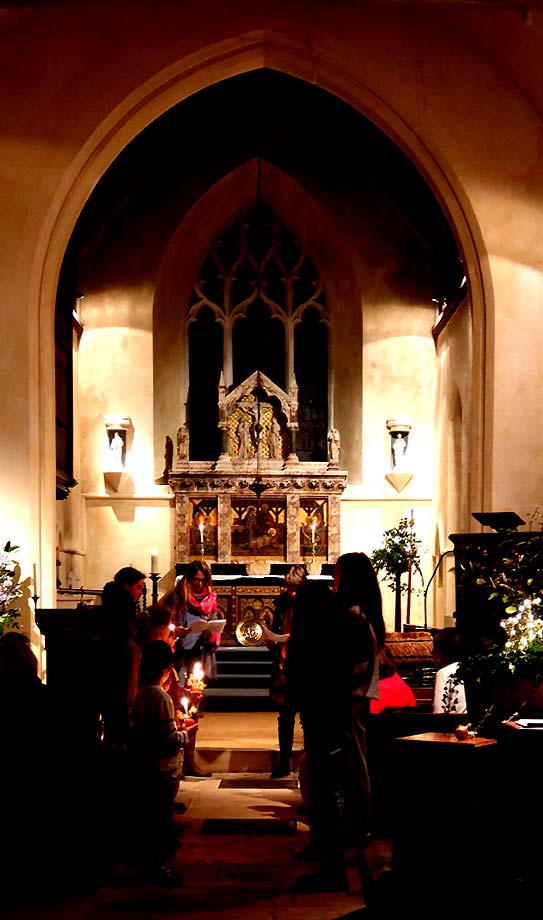[Services] [2019 Harvest Festival Pictures] [Church News]
[News Headlines] [Home] [The Farringdon Yew]
Next Coffee Morning : Sat 4th October - 10am - 11:30 - All Welcome

Farringdon
Christingle
2023
Money raised by the Funding Campaign launched by the Parochial Church Council has been put to good use,
providing finance for the construction of a new support structure to
preserve the older of the two Ancient Yew Trees in the Churchyard
Full Details Here
The Church decorated to celebrate the 2019 Harvest Festival




In common with all Parish Churches, All Saints in constant need of restoration.

In 1999 , a special
All Saints Restoration Fund was set up to refurbish and enhance the interior of
the ancient building. The wooden shingles on the spire roof also needed replacing
a problem exacerbated by the attentions of a Green Woodpecker which bored holes
in the woodwork to extract the insects thriving in the decaying wood.
The Church was closed throughout the Summer of 2001 for a major restoration and the newly refurbished Church reopened in time for Harvest Festival in the Autumn.

In
2005 after a pastoral reorganisation of Local Parishes, Farringdon became part of
the newly created Northanger Benefice which brought together the Parishes of Chawton,
Selborne, East Worldham, West Worldham Hartley Mauditt, Newton Valence, East Tisted,
Oakhanger and Kingsley.

Gilbert White, the Selborne naturalist, was curate at All Saints for many years before he took up his post as curate at Selborne, in the neighbouring parish.

Although the present church building dates back to the 1300's, structural changes took place in the 19th century under the influence of Rev Thomas Massey, rector for 62 years.
Massey was something of an eccentric with a penchant for building.
He
was responsible for the construction of
'Massey's
Folly', just across the road from the Church, the building which once housed the Village School and the Village Hall.
The Rev. Massey died in 1919, before the building was completed, he is buried alongside his wife, near the Church door, their graves marked with Celtic crosses
The war memorials and a book of remembrance record the sacrifice of local people killed in action in the two world wars. Other memorials record lives of local people who have served both the church and community in their lifetime.

Not normally visible to visitors is the stained glass window in the vestry designed by a village resident Hugh Powell, who moved to Farringdon in 1958. His work repairing bomb damaged stained glass was much in demand. His also designed a window in Southwark Cathedral in London.
Ancient wall paintings of an Apostle dating back to 1340 were discovered in the Church when layers of old lime wash began to flake off medieval plaster work. In 1988 experts were consulted to carry out an investigation, so that decisions could be made about conservation.
Two paintings were discovered - both 'Dooms' or 'Last Judgements', with Christ as the central figure displaying the wounds of his crucifixion. The paintings were faded in places and difficult to make out, but some details are still clear.
Unfortunately these paintings are in the loft space above the ceiling and are not accessible to visitors, although when the recent repairs were carried out it was discovered that the ends of the ceiling timber supports had crumbled away, with only the plaster work preventing an unscheduled descent, which would have given those of the congregation who were still conscious, a clear view of the old paintings.
Until 1969, when an electric punp was fitted, the Church Organ was pumped by hand which provided a ready source of pocket money for the village lads.
© farringdon.biz MMX






